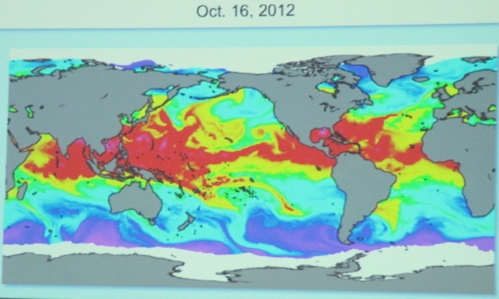UC Blogs
A Bug-Eat-Bug World
It's a bug-eat-bug world out there. Today we watched a syrphid fly, aka "hover fly" and "flower fly," circling a blanket flower (Gaillardia) and...
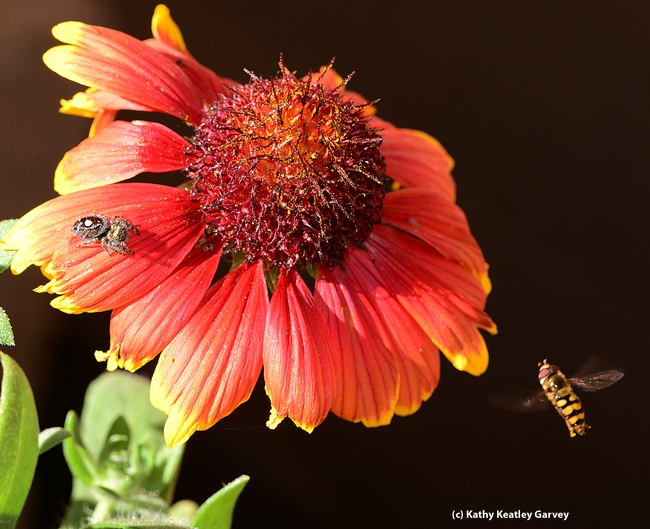
Syrphid fly (right) circles a blanket flower, unaware of the jumping spider. (Photo by Kathy Keatley Garvey)
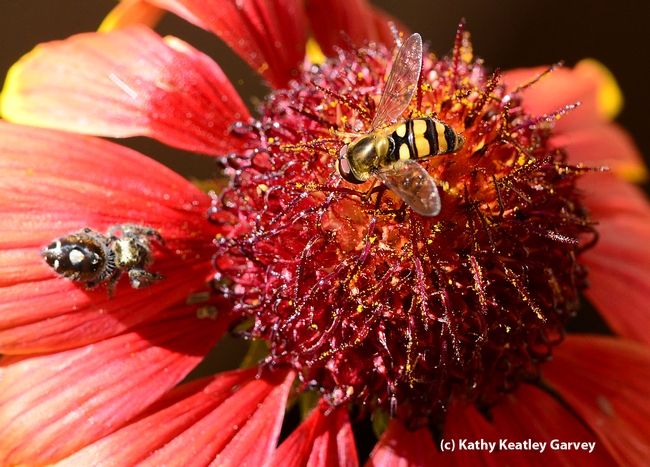
Syrphid fly sipping nectar close to the predator. (Photo by Kathy Keatley Garvey)

End result--the jumping spider feasting on the syrphid fly. (Photo by Kathy Keatley Garvey)
Climate is indeed an angry beast
Global warming promises to be among the most immense challenges to human adaptation in history, as big as social media. But the climate topic has been overshadowed in recent years by the recession. Just as the Dow Jones can’t be described by the fluctuations of a single decade, climate science is not defined by periods less than centuries.
These thoughts were shared at a breakfast Oct. 16 at UC Davis hosted by Capital Public Radio. The speaker: Ben Santer, MacArthur Fellow (1998), National Academy Member (2012), and atmospheric scientist at Lawrence Livermore National Laboratory.
Santer said that when he hears about the tragedy of burdening youth with the national debt, he would like to hear more about the burdening of youth with global climate change. The verbal references have vaporized.
It was appropriate that Santer opened his talk with a graphic depicting changes in global water vapor, the greenhouse gas that Earth relies on to sustain its water cycles. This greenhouse gas inspired 10,000 years of human supplication to climate gods that could meet their need for rain. But he didn’t come to talk about the largely unpredictable weather (he calls this noise), except as an indicator of a more predictable long-term climate trend (he calls this the signal). Scientists have methods to work out the signal to noise ratio and finding the major trends among frequent short-term fluctuations.
Santer has been involved with the IPCC since 1990. It wasn’t until 1995 that this international mouthpiece of global climate science announced that the evidence suggested that there was a human influence on global climate.
To his surprise, Santer spent the next year and a half defending that cautionary statement, and his research role turned into that of a messenger. Two more IPCC reports and 17 years later, he is still confirming human influences through testimony to the U.S. House of Representatives’ Committee on Global Warming (2010). His message remains the same, “Climate science is not a scam, a hoax, or a conspiracy.” It is not a belief system, so he doesn’t have to “believe in it.” He does believe in scientific facts, and proving hypotheses. His graphics make a strong case for the science, but his research problem is one of communication. He resolved to talk to everyone he meets about it.
His advice, when asked this question from the audience, would be to make the U.S. a leader in solutions rather than a leader in finger pointing. He believes that the leaders who make economic decisions based on climate science will be better able to adapt and manage the impending change, however placing blame on other nations is counterproductive to this goal.
What can we expect from the next IPCC global climate report? Santer predicts that there will be a downsizing of scale to regional scenarios. Following sage advice, if the problem is too big, break it down. His last word, a quote from climate scientist Wally Broecker, “Climate is an angry beast and we are poking it with a sharp stick.”
What Do You Want for Your Birthday?
Several women I know asked for jewelry, cruises or trips to Las Vegas; but I asked for raised beds. Walking around the backyard I picked out a good spot -- taking in consideration the hours of sunlight -- my husband and I visited the various box stores in the area. Redwood was chosen because of its ability to last longer. Our measurements were six feet long, four feet wide and 22 inches high. The height was important to both of us because we are in our seventies and don't bend and stretch as easily as we used to.
We lined the box sides using staples to keep the soil from leaking out between the planks. After doing the math we ordered three yards of special soil mixed especially for raised beds. In addition, I incorporated four bags of dried chicken manure from a local organic chicken farm.
We enjoyed a bounty of vegetables, greens and herbs and I was amazed at how well plants grew in a raised bed. I found it very interesting that beneficial insects easily found the plants growing in a high rise environment, but the troublesome pests appear to have a more difficult time finding the plants. Very few problems.
The first raised bed we built provided us with strawberries throughout the season. I am still able to go out in the morning every couple of days and find a few small and delicious berries. I am now thinking of changing bed # 1 as a herb garden instead of having the herbs spread all over the yard.
How lucky I am to have a husband who indulges my 'crazy birthday ideas' -- that end up benefiting the both of us!

The beginning of the raised bed. (photos by Danielle Wilkowski)

Vegetables spilling out of the raised bed.

Yum! Strawberries!
Exotic pitahaya possible desert cash crop
A native of Mexico and South American, the beautiful tropical fruit pitahaya - also known as dragon fruit - could be a viable crop for Southern California desert, said an article in the Desert Sun.
Ramiro Lobo, UC Cooperative Extension advisor in San Diego County, shared the results of pitahaya studies conducted in San Diego and Irvine with a group of inland desert farmers recently.
“The fruit size and quality is good ... we’re getting great marketable yields,” Lobo said.
In March, five varieties of the fruit were test-planted at UC Riverside's Coachella Valley Agricultural Research Station in Oasis.
“We’re selecting varieties that can tolerate the heat,” said José Luis Aguiar, UCCE advisor in Riverside County. “They’re doing well in San Diego County and Irvine and we’re trying to extend the range.”
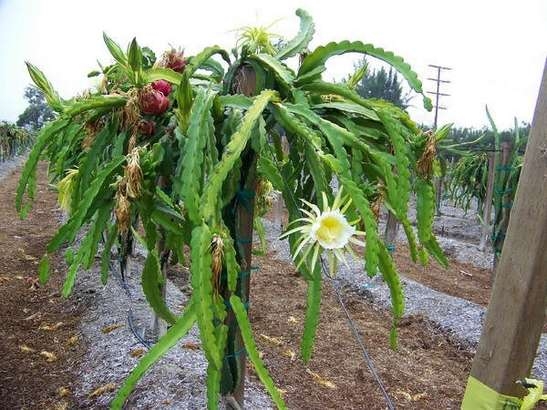
Dragon fruit grows on a cactus plant. (Photo: Jose Luis Aguiar)
Well, Hello There!
At first they appeared on our pomegranate tree, our 85-year-old pomegranate tree. Then they migrated over to our passion flower vine, Passiflora,...
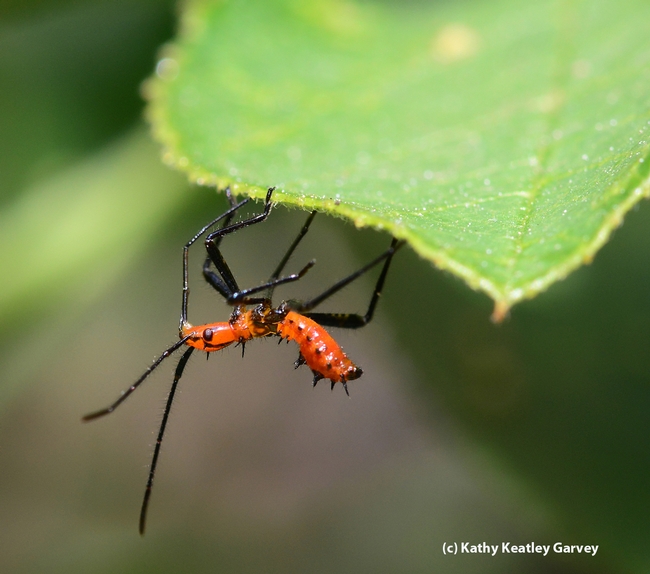
Leaffooted bug nymphs, Leptoglossus clypealis. (Photo by Kathy Keatley Garvey)

Leaffooted bug nymphs, Leptoglossus clypealis. crowd a leaf of a passion flower vine. Note the yellow Gulf Fritillary eggs on the leaf. (Photo by Kathy Keatley Garvey)
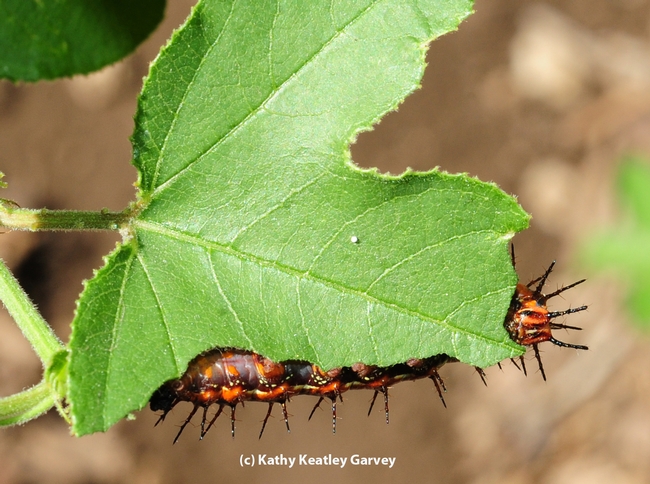
Close-up of a Gulf Fritillary caterpillar. These leaffooted bug nymphs are sharing leaves of the Passiflora with Gulf Fritillary caterpillars. (Photo by Kathy Keatley Garvey)



